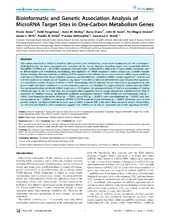Bioinformatic and Genetic Association Analysis of MicroRNA Target Sites in One-Carbon Metabolism Genes
Stone, Nicole; Pangilinan, Faith; Molloy, Anne M.; Shane, Barry; Scott, John M.; Ueland, Per Magne; Mills, James L.; Kirke, Peader N.; Sethupathy, Praveen; Brody, Lawrence C.
Peer reviewed, Journal article
Published version
Permanent lenke
https://hdl.handle.net/1956/5650Utgivelsesdato
2011-07-12Metadata
Vis full innførselSamlinger
Originalversjon
https://doi.org/10.1371/journal.pone.0021851Sammendrag
One-carbon metabolism (OCM) is linked to DNA synthesis and methylation, amino acid metabolism and cell proliferation. OCM dysfunction has been associated with increased risk for various diseases, including cancer and neural tube defects. MicroRNAs (miRNAs) are ,22 nt RNA regulators that have been implicated in a wide array of basic cellular processes, such as differentiation and metabolism. Accordingly, mis-regulation of miRNA expression and/or activity can underlie complex disease etiology. We examined the possibility of OCM regulation by miRNAs. Using computational miRNA target prediction methods and Monte-Carlo based statistical analyses, we identified two candidate miRNA ‘‘master regulators’’ (miR-22 and miR-125) and one candidate pair of ‘‘master co-regulators’’ (miR-344-5p/484 and miR-488) that may influence the expression of a significant number of genes involved in OCM. Interestingly, miR-22 and miR-125 are significantly up-regulated in cells grown under low-folate conditions. In a complementary analysis, we identified 15 single nucleotide polymorphisms (SNPs) that are located within predicted miRNA target sites in OCM genes. We genotyped these 15 SNPs in a population of healthy individuals (age 18–28, n = 2,506) that was previously phenotyped for various serum metabolites related to OCM. Prior to correction for multiple testing, we detected significant associations between TCblR rs9426 and methylmalonic acid (p = 0.045), total homocysteine levels (tHcy) (p = 0.033), serum B12 (p , 0.0001), holo transcobalamin (p , 0.0001) and total transcobalamin (p , 0.0001); and between MTHFR rs1537514 and red blood cell folate (p , 0.0001). However, upon further genetic analysis, we determined that in each case, a linked missense SNP is the more likely causative variant. Nonetheless, our Monte-Carlo based in silico simulations suggest that miRNAs could play an important role in the regulation of OCM.

